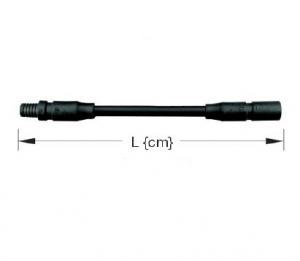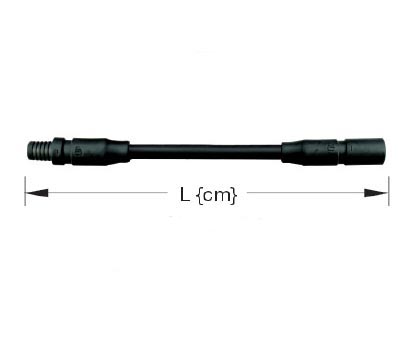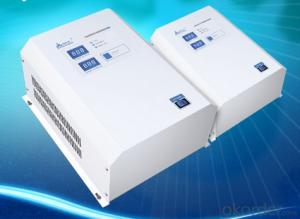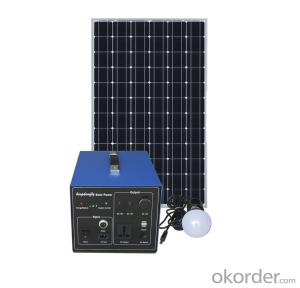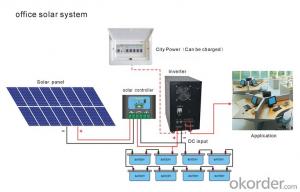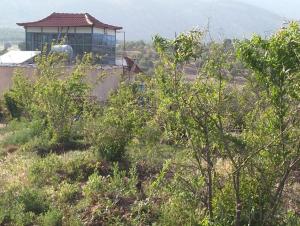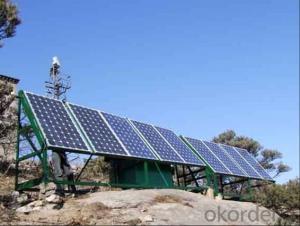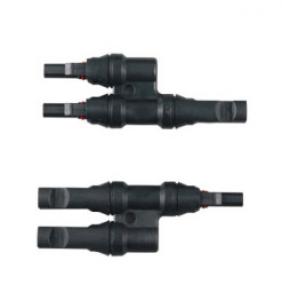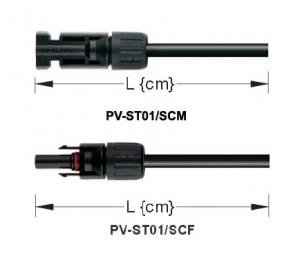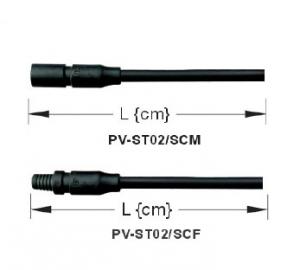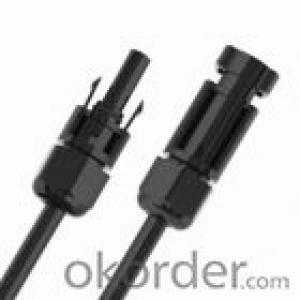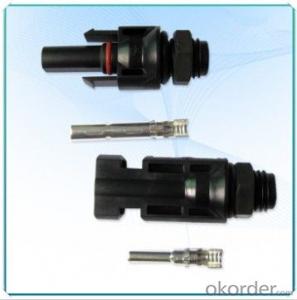Adithya Solar Energy Systems Solar Cable Connector ST01 SC
- Loading Port:
- China Main Port
- Payment Terms:
- TT OR LC
- Min Order Qty:
- -
- Supply Capability:
- 10000 set/month
OKorder Service Pledge
OKorder Financial Service
You Might Also Like
Solar Cable-Connectors,Due to highly robustness,UV-resistance,the touch protection a high grade connection is guaranteed for many years
Rated voltage 1000 V
Rated current 20A
Dia.of pin or socket 3mm
Protection degree(mated,junction box closed/unmated) IP67/IP2X
Operating temperature -40 °c to +85 °c
Contact material Copper,silver plated
Cable cross on request: 2.5mm2 4mm2
- Q: Can solar energy systems be used for powering off-grid eco-sanctuaries?
- Yes, solar energy systems can definitely be used for powering off-grid eco-sanctuaries. In fact, they are an ideal solution for such locations as they provide a sustainable and renewable energy source. Solar panels can generate electricity during the day, and excess energy can be stored in batteries for use at night or during cloudy periods. This not only reduces reliance on traditional power sources but also helps to minimize the environmental impact of these sanctuaries by reducing carbon emissions.
- Q: What is the impact of tree shade on the performance of solar panels?
- The performance of solar panels can be greatly affected by the presence of tree shade. When trees cast shadows on solar panels, their ability to convert sunlight into electricity is significantly diminished. This occurs because the shade prevents direct sunlight from reaching the panels, resulting in a decrease in overall efficiency. Shade on solar panels gives rise to a phenomenon called "partial shading," where only a portion of the panel is shaded. In such cases, the shaded section acts as an obstacle, limiting the unshaded portion from producing electricity at its full potential. Consequently, the solar panel system experiences a decline in energy production. Furthermore, tree shade can cause an imbalance in the output of solar panels that are connected in series. When one panel is shaded, it becomes a bottleneck for the flow of electricity, leading to a significant decrease in the performance of the entire series. As a result, the overall energy generation of the solar system is compromised. It is important to note that the impact of tree shade on solar panels varies depending on various factors, such as the intensity and duration of the shade, the orientation and tilt angle of the panels, and the efficiency of the panels themselves. Additionally, advancements in solar panel technology, such as the use of bypass diodes in modern systems, can help alleviate the negative effects of shading to a certain extent. To optimize the performance of solar panels in the presence of tree shade, careful consideration must be given to the placement and design of the solar panel system. This may involve actions like trimming or removing trees that cast shade on the panels, adjusting the tilt angle of the panels to minimize shading, or exploring alternative installation locations where shade is less of a concern. In conclusion, tree shade can significantly impact the performance of solar panels by reducing their efficiency and energy production. Therefore, it is crucial to thoroughly evaluate the effects of shade when planning and designing a solar panel installation to maximize its effectiveness.
- Q: Can solar energy systems be used in powering warehouses or distribution centers?
- Yes, solar energy systems can definitely be used in powering warehouses or distribution centers. In fact, many businesses are increasingly adopting solar energy as a sustainable and cost-effective solution for their energy needs. Warehouses and distribution centers are typically large facilities with ample roof space, making them ideal candidates for solar panel installations. By installing solar panels on the roof or ground of these facilities, the generated solar energy can be used to power various operations within the warehouse or distribution center. This includes lighting systems, climate control, refrigeration units, conveyor belts, and other machinery or equipment. The generated energy can also be stored in batteries for later use during cloudy days or at night. Several advantages make solar energy systems a great fit for warehouses and distribution centers. Firstly, solar power helps reduce reliance on the traditional grid, leading to reduced electricity bills and long-term cost savings. Moreover, as solar energy is a renewable and clean energy source, using it reduces greenhouse gas emissions and contributes to a more sustainable business operation. In addition to the cost and environmental benefits, solar energy systems can also provide businesses with energy independence and resilience. By generating their own power, warehouses and distribution centers are less vulnerable to power outages or fluctuations in the grid, ensuring uninterrupted operations and minimizing downtime. Overall, the use of solar energy systems in powering warehouses and distribution centers presents numerous advantages, including cost savings, sustainability, energy independence, and operational resilience. As a result, more and more businesses are embracing solar energy as a reliable and efficient solution for their energy needs in these types of facilities.
- Q: Can solar energy systems be used in areas with limited access to storage solutions?
- Yes, solar energy systems can be used in areas with limited access to storage solutions. In such cases, solar energy can be utilized directly as it is generated during daylight hours, without the need for storage. This is particularly beneficial in regions with abundant sunlight, where solar power can provide a reliable and sustainable source of electricity during daylight hours, reducing the reliance on traditional energy sources and minimizing the need for storage solutions.
- Q: What is the impact of roof orientation on the performance of solar panels?
- The efficiency and energy generation of solar panels are greatly affected by the orientation of the roof. The direction in which the roof faces, whether it be south, east, west, or north, plays a significant role. Solar panels perform best when installed on a south-facing roof as it allows them to receive the maximum amount of sunlight throughout the day. South-facing roofs receive direct sunlight for a longer duration, resulting in increased solar energy capture. If the roof faces east or west, the solar panels will still receive sunlight, but their energy generation may be reduced. East-facing roofs receive morning sunlight, which is advantageous in regions with higher morning electricity demand. However, energy production may be lower compared to south-facing roofs, as they do not receive sunlight for the entire day. Similarly, west-facing roofs receive afternoon sunlight, which may be beneficial in areas with higher afternoon electricity demand. North-facing roofs have the least favorable orientation for solar panels. They receive the least amount of direct sunlight, resulting in lower energy generation potential. In regions with predominantly northern orientation, solar panels may not be the most efficient or cost-effective solution for renewable energy generation. Aside from orientation, the tilt angle of the roof also impacts solar panel performance. The ideal tilt angle is typically determined based on the location's latitude. Adjusting the tilt angle can optimize sunlight exposure and maximize energy generation. To ensure optimal energy production and maximize the benefits of solar power, it is crucial to consider the orientation and tilt of the roof when installing solar panels. South-facing roofs offer the highest energy generation potential, while east, west, and north-facing roofs may have varying levels of efficiency.
- Q: What are the environmental impacts of manufacturing solar panels?
- The manufacturing of solar panels has both positive and negative environmental impacts. On the positive side, solar panels produce clean and renewable energy, reducing the demand for fossil fuels and mitigating greenhouse gas emissions. This helps combat climate change and air pollution, which are major environmental concerns. However, the production process of solar panels is not entirely without negative consequences. The initial stage involves the extraction and processing of raw materials, such as silicon, silver, aluminum, and glass, which can have environmental impacts. Mining for these materials can lead to habitat destruction, soil erosion, and water pollution if not properly managed and regulated. Moreover, the manufacturing process itself requires energy, which is often derived from conventional power sources like coal or natural gas. This can contribute to carbon emissions and air pollution during the production phase, offsetting some of the environmental benefits of solar energy. Additionally, the disposal of solar panels at the end of their life cycle can pose environmental challenges. Most solar panels contain hazardous materials, such as lead and cadmium, which can leach into the soil and water if not properly handled. Ensuring proper recycling and disposal methods for end-of-life solar panels is crucial to minimize potential environmental harm. Despite these concerns, it is important to note that the environmental impacts of manufacturing solar panels are relatively minimal compared to the long-term benefits they offer in terms of clean energy generation and reducing greenhouse gas emissions. Continuous advancements in technology and manufacturing processes are also helping to minimize the environmental footprint of solar panel production. Overall, while there are some environmental consequences associated with manufacturing solar panels, their positive impacts on reducing carbon emissions and promoting renewable energy far outweigh the negatives. It is essential to continue investing in research and development to further improve the sustainability of solar panel production and address any potential environmental challenges.
- Q: Can solar energy systems be used in conjunction with battery storage?
- Yes, solar energy systems can be used in conjunction with battery storage. This allows excess solar energy generated during the day to be stored in batteries for later use when the sun is not shining, such as during the night or during cloudy days. Battery storage enables a more reliable and consistent supply of electricity from solar energy, increasing energy independence and resilience.
- Q: Can solar energy systems be combined with energy storage technologies like batteries?
- Yes, solar energy systems can be combined with energy storage technologies like batteries. This integration allows excess energy generated by solar panels to be stored in batteries for later use, providing a reliable and continuous power supply even when the sun is not shining.
- Q: Can solar energy systems be used in powering government buildings or offices?
- Government buildings or offices can definitely utilize solar energy systems as a means of power. In fact, numerous governments across the globe have already embraced solar energy as a sustainable and cost-effective solution to fulfill their electricity needs. There are multiple reasons why solar energy systems are highly suitable for government buildings or offices. Firstly, these buildings often possess spacious rooftops or open areas that are well-suited for the installation of solar panels. These panels have the ability to convert sunlight into electricity, which can then be utilized to power the buildings' lighting, HVAC systems, and other electrical appliances. Secondly, solar energy systems offer substantial cost savings in the long run. Although the initial investment may be higher in comparison to traditional energy sources, solar panels have a long lifespan and require minimal maintenance. This makes them a financially appealing option for government agencies, as they can reduce their dependence on costly grid electricity and save taxpayer money over time. Moreover, by utilizing solar energy, government buildings can significantly diminish their carbon footprint and contribute to environmental sustainability. Solar power is a clean and renewable energy source that generates no greenhouse gas emissions during operation. This aligns with the global efforts to combat climate change and achieve sustainability goals. Furthermore, solar energy systems can also serve as a reliable source of electricity, especially when combined with energy storage technologies like batteries. This ensures that government buildings or offices have a continuous power supply, even during grid outages or emergencies. In conclusion, solar energy systems are a practical and advantageous choice for powering government buildings or offices. They offer a multitude of benefits, including cost savings, environmental sustainability, and reliable electricity supply. As governments worldwide strive to transition to clean energy sources, solar power is increasingly gaining popularity as an ideal option for powering government infrastructure.
- Q: Are there any risks of electrical overloading with solar energy systems?
- Solar energy systems do pose certain risks of electrical overloading. One of the primary causes of overloading is when the capacity of the solar panels does not match the electrical load. If the panels generate more electricity than what is being consumed or stored, it can result in an overload within the system. Another risk arises from the need for inverters in solar energy systems. These inverters are responsible for converting the DC power generated by the panels into AC power that can be utilized in homes or businesses. However, inverters have their limits, and if the panels produce more electricity than the inverter can handle, overloading can occur. Furthermore, overloading can also be caused by wiring or connection issues. Insufficiently sized wiring or loose and faulty connections can increase resistance and lead to overheating, ultimately resulting in overloading. To mitigate these risks, it is crucial to accurately size the solar energy system to match the electrical load. This necessitates considering factors such as average energy consumption, peak energy demand, and the capacity of the inverter. Additionally, it is essential to hire certified professionals to ensure proper wiring and connections, which should be regularly inspected for signs of wear or damage. Moreover, the installation of safety mechanisms like circuit breakers and surge protectors is vital for preventing overloading and safeguarding the solar energy system against potential damage. Regular maintenance and monitoring of the system can also aid in early issue detection and prevention of overloading.
Send your message to us
Adithya Solar Energy Systems Solar Cable Connector ST01 SC
- Loading Port:
- China Main Port
- Payment Terms:
- TT OR LC
- Min Order Qty:
- -
- Supply Capability:
- 10000 set/month
OKorder Service Pledge
OKorder Financial Service
Similar products
Hot products
Hot Searches
Related keywords
